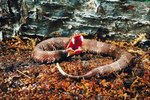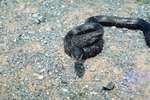
Hook-nosed sea snakes (Enhydrina schistosa) are poisonous reptiles that are prevalent throughout their native lands of Asia and Australia. Also frequently referred to as beaked sea snakes, these creatures are inhabitants of countries such as Saudi Arabia, Vietnam, Thailand, China, Pakistan and the Philippines.
Background
Some hook-nosed sea snakes are smallish, while others are more moderate in size. They generally grow to mature lengths of between 3 and 5 feet. Adult hook-nosed sea snakes typically weigh in at 4 pounds or less. The top parts or their bodies are pale gray, while the lower parts are white. Their bodies also feature subtle grayish-blue barring. Hook-nosed sea snakes have narrow physiques and angular heads.
Nose
One cool and memorable hook-nosed sea snake physical trait involves their noses. Their heads slope forward at their nose area, which is what gives them their famous "beak" or "hook-nose" quality.
Tail
Another interesting hook-nosed sea snake feature relates to their tails, which have outlines that are reminiscent of oars. This oar-like form enables them to navigate their aquatic environments with more ease.
Habitat
Hook-nosed sea snakes are capable of managing in a broad array of living environments. Some typical locations for these sea snakes are inlets, lagoons, ports, rivers, swamps, estuaries and settings with lots of mangroves. Some hook-nosed sea snakes also reside in open waters, although in areas of insignificant depth.
Venom
One decidedly uncool fact about hook-nosed sea snakes involves their venom. A single bite from one of these snakes is potent enough to produce deadly results for 50 human beings. Although hook-nosed sea snakes don't bite people all too frequently, they remain an extreme danger to them. A bite from one of them calls for urgent medical attention, no exceptions.
Diet
Shrimp and catfish constitute the bulk of the hook-nosed sea snake diet. They track down their next meals either by using their noses or by feeling them. They finally eat their prey once it ceases resisting. That way, they can tuck into their findings starting at the head. Most of their eating occurs at night.
Breathing
Hook-nosed sea snakes have to venture to the top of the water to take in air, although they can remain underwater for rather substantial periods of time. These snakes are capable of staying down in the water for as long as half an hour to two hours before coming back up again to breathe. Their lungs -- which are, like a snake's body, physically long -- work well for gas exchange purposes.
References
Photo Credits
-
NA/AbleStock.com/Getty Images




